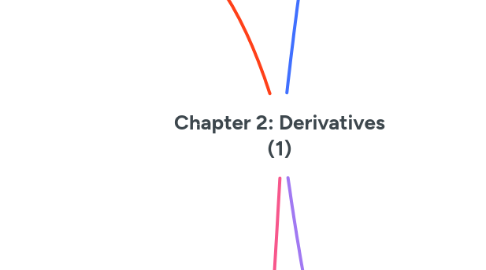
1. 1 Futures markets
1.1. 1.1 Nature of futures
1.1.1. A futures contract is a standardised, exchange-tradable contract between two parties to trade a specified asset on a set date in the future at a specified price.
1.1.2. A financial future is a standardised and exchange-tradable, legally binding agreement to trade a specified quantity of an underlying financial security or instrument on a specified date and at a specified price.
1.1.3. Range of futures
1.1.3.1. bond futures
1.1.3.2. currency futures
1.1.3.3. short interest rate futures
1.1.3.4. equity index futures
1.2. 1.2 Operation of futures exchanges
1.2.1. The contract will typically specify
1.2.1.1. the unit of trading
1.2.1.2. how the settlement price is to be determined
1.2.1.3. exact details of the underlying asset (ie type and quality)
1.2.1.4. the delivery date
1.2.2. This minimum price movement is known as the contract’s tick size
1.2.3. In effect the clearing house becomes the counterparty to both of the parties to the transaction. As such the clearing house guarantees each side of the original transaction, subject to its capital resources
1.2.3.1. Two key advantages
1.2.3.1.1. largely removes counterparty credit risk
1.2.3.1.2. Each contract is indistinguishable from all others
1.2.4. Margin is the collateral that each party to an exchange-traded derivative must deposit with the clearing house
1.2.5. It is changed on a daily basis through additional payments of variation margin. This variation margin ensures that the clearing house’s exposure to counterparty risk is controlled.
1.2.6. However, they need only to top it back up to the initial margin level if it falls below a specified level – the maintenance margin.
1.2.7. The process of daily margin requirement changes is known as marking to market.
1.2.8. The settlement process in futures markets is known as delivery. Most positions in futures markets are closed out before delivery by taking an opposite position. For example, buyers of a contract can later close out their positions by selling an equivalent contract. Their net position is then nil.
1.2.9. The market price of the asset needs to be precisely defined and the exchange does this for futures that can be cash settled by publishing an exchange delivery settlement price (EDSP)
1.2.10. The number of contracts outstanding at any one time is known as the open interest.
1.3. 1.3 Role of the clearing house
1.3.1. counterparty to all trades
1.3.2. guarantor of all deals (removing credit risk)
1.3.3. registrar of deals
1.3.4. holder of deposited margin
1.3.5. facilitator of the marking to market process.
2. 0 Introduction
2.1. A derivative is a financial instrument whose value is dependent on (or derived from) the value of another, underlying asset.
2.2. Derivatives can be used to:
2.2.1. control credit risk ·
2.2.2. reduce market risk
2.2.3. increase risk in order to enhance returns
2.2.4. switch asset allocations
2.3. two distinct marketplaces
2.3.1. exchange-traded derivatives
2.3.2. over-the-counter derivatives
3. 3 Over-the-counter markets
3.1. 3.1 Introduction
3.1.1. forwards and swaps are both ‘derivative instruments’. However, they are ‘over-the-counter’ instruments, ie they are individually arranged on a non-standardised basis over the telephone with banks rather than being traded on a recognised exchange.
3.2. 3.2 Forwards
3.2.1. A forward contract is a non-standardised and privately negotiated contract between two parties to trade a specified asset on a set date in the future at a specified price
3.3. 3.3 Swaps
3.3.1. A swap is a contract between two parties under which they agree to exchange a series of payments according to a prearranged formula.
3.3.2. two most common types of swaps are
3.3.2.1. interest rate swaps
3.3.2.2. currency swaps
3.3.3. Main risks
3.3.3.1. Markert risk
3.3.3.2. Credit risk
3.4. 3.4 Other derivative products
3.4.1. **Guaranteed equity products (GEPs)** offer a return that is linked to an equity index, but with a minimum guaranteed return, often of zero.
3.4.2. **Structured notes** are non-standard securities that are structured so as to meet the particular risk and return requirements of investors.
4. 2 Options markets
4.1. 2.1 Definition
4.1.1. options are contracts agreed between investors to trade in an underlying security at a given date at a set price. The difference is that the holder of the option is not obliged to trade – hence the name ‘option’. The other party, the writer, is obliged to trade if the holder of the option wants to.
4.1.2. A call option gives its holder the right, but not the obligation, to buy a specified asset on a set date in the future for a specified price.
4.1.3. A put option gives its holder the right, but not the obligation, to sell a specified asset on a set date in the future for a specified price.
4.1.4. The exercise price is the price at which an underlying security can be sold to (for a put) or purchased from (for a call) the writer or issuer of an option (or option feature on a security). Also known as the strike price.
4.1.5. The writer of an option is the seller of that option.
4.1.6. To buy either a call or a put option you pay a small amount of money up front to the writer of the option. This money, the option premium, is non-returnable
4.2. 2.2 Basic option positions
4.2.1. buying a call option
4.2.2. buying a put option
4.2.3. ‘writing’ (ie selling) a call option
4.2.4. ‘writing’ (ie selling) a put option
4.3. 2.3 Option trading
4.3.1. Unlike futures, when options are traded, margin is only required from only one of the parties to an options contract. Otherwise all else is the same
